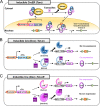Mouse Cre-LoxP system: general principles to determine tissue-specific roles of target genes
- PMID: 30671100
- PMCID: PMC6333611
- DOI: 10.5625/lar.2018.34.4.147
Mouse Cre-LoxP system: general principles to determine tissue-specific roles of target genes
Abstract
Genetically engineered mouse models are commonly preferred for studying the human disease due to genetic and pathophysiological similarities between mice and humans. In particular, Cre-loxP system is widely used as an integral experimental tool for generating the conditional. This system has enabled researchers to investigate genes of interest in a tissue/cell (spatial control) and/or time (temporal control) specific manner. A various tissue-specific Cre-driver mouse lines have been generated to date, and new Cre lines are still being developed. This review provides a brief overview of Cre-loxP system and a few commonly used promoters for expression of tissue-specific Cre recombinase. Also, we finally introduce some available links to the Web sites that provides detailed information about Cre mouse lines including their characterization.
Keywords: Cre portal sites; Cre-loxP system; tissue specific promoter.
Conflict of interest statement
Conflict of interests: The authors declare that there is no financial conflict of interests to publish these results.
Figures


Similar articles
-
Cre-loxP-Mediated Recombination: General Principles and Experimental Considerations.Curr Protoc Mouse Biol. 2017 Mar 2;7(1):1-12. doi: 10.1002/cpmo.22. Curr Protoc Mouse Biol. 2017. PMID: 28252198
-
Characterization and Validation of Cre-Driver Mouse Lines.Curr Protoc Mouse Biol. 2011 Mar 1;1(1):1-15. doi: 10.1002/9780470942390.mo100103. Curr Protoc Mouse Biol. 2011. PMID: 26068985
-
The generation and characterization of novel Col1a1FRT-Cre-ER-T2-FRT and Col1a1FRT-STOP-FRT-Cre-ER-T2 mice for sequential mutagenesis.Dis Model Mech. 2015 Sep;8(9):1155-66. doi: 10.1242/dmm.021204. Epub 2015 Jul 16. Dis Model Mech. 2015. Retraction in: Dis Model Mech. 2016 Dec 1;9(12):1513. doi: 10.1242/dmm.028340. PMID: 26183214 Free PMC article. Retracted.
-
Conditional gene targeting in the mouse nervous system: Insights into brain function and diseases.Pharmacol Ther. 2007 Mar;113(3):619-34. doi: 10.1016/j.pharmthera.2006.12.003. Epub 2007 Jan 10. Pharmacol Ther. 2007. PMID: 17289150 Review.
-
The Cre-loxP system: a versatile tool for targeting genes in a cell- and stage-specific manner.Cell Transplant. 2000 Nov-Dec;9(6):805-15. doi: 10.1177/096368970000900607. Cell Transplant. 2000. PMID: 11202567 Review.
Cited by
-
Systems immunology approaches to study T cells in health and disease.NPJ Syst Biol Appl. 2024 Oct 9;10(1):117. doi: 10.1038/s41540-024-00446-1. NPJ Syst Biol Appl. 2024. PMID: 39384819 Free PMC article. Review.
-
Unraveling protein dynamics to understand the brain - the next molecular frontier.Mol Neurodegener. 2022 Jun 18;17(1):45. doi: 10.1186/s13024-022-00546-8. Mol Neurodegener. 2022. PMID: 35717317 Free PMC article. Review.
-
Wide field-of-view fluorescence imaging for organ-level lineage tracing of rare intestinal stem cell populations.J Biomed Opt. 2023 Sep;28(9):096004. doi: 10.1117/1.JBO.28.9.096004. Epub 2023 Sep 13. J Biomed Opt. 2023. PMID: 37711357 Free PMC article.
-
Annotated expression and activity data for murine recombinase alleles and transgenes: the CrePortal resource.Mamm Genome. 2022 Mar;33(1):55-65. doi: 10.1007/s00335-021-09909-w. Epub 2021 Sep 4. Mamm Genome. 2022. PMID: 34482425 Free PMC article. Review.
-
Protocol for the establishment of a serine integrase-based platform for functional validation of genetic switch controllers in eukaryotic cells.PLoS One. 2024 May 23;19(5):e0303999. doi: 10.1371/journal.pone.0303999. eCollection 2024. PLoS One. 2024. PMID: 38781126 Free PMC article.
References
-
- Nagy A. Cre recombinase: the universal reagent for genome tailoring. Genesis. 2000;26(2):99–109. - PubMed
-
- Meinke G, Bohm A, Hauber J, Pisabarro MT, Buchholz F. Cre Recombinase and Other Tyrosine Recombinases. Chem Rev. 2016;116(20):12785–12820. - PubMed
-
- Sternberg N, Hamilton D. Bacteriophage P1 site-specific recombination. I. Recombination between loxP sites. J Mol Biol. 1981;150(4):467–486. - PubMed
-
- Sternberg N, Sauer B, Hoess R, Abremski K. Bacteriophage P1 cre gene and its regulatory region. Evidence for multiple promoters and for regulation by DNA methylation. J Mol Biol. 1986;187(2):197–212. - PubMed
Publication types
LinkOut - more resources
Full Text Sources
Other Literature Sources

